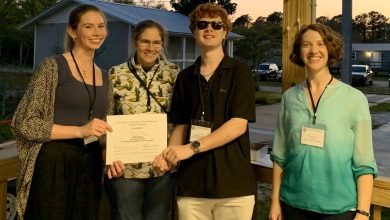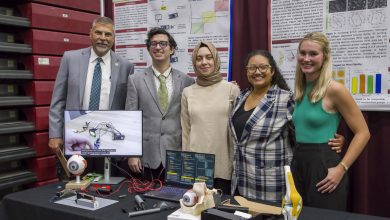Hurricane Sandy: Flying Into the Eye of the Storm
During my summer internship at the NOAA Aircraft Operations Center (AOC), I had the honor to meet a majority of the NOAA Hurricane Hunter pilots. Alongside my new-found contacts, I enrolled in a Water Survival training course, which certified me to fly aboard NOAA aircraft for no less than five years. After leaving NOAA AOC, I kept in contact with my coworkers and when it was mentioned there was a seat available for me on the Hurricane flight into SANDY on October 26, you know I jumped at the chance.
I made the drive out to MacDill AFB that Friday morning and suited up for the mission. Pre-flight began four hours before the scheduled departure time with maintenance readying the aircraft. We had a crew briefing two hours prior to takeoff where the route of flight was planned, drop locations mapped, mission specifics finalized and crew lists dispersed. We had three pilots on board and one flight engineer. The WP-3D Orion aircraft needs a crew of two pilots and one flight engineer; with three pilots we were able to rotate so the off pilot could catch cat naps between passes through the storm.

Our flight took us into the center of hurricane Sandy, which at the time was located just north of Jamaica. The transit to the edge of the storm was a 40 minute flight; about 100 miles off the coast of Florida. While flying out to the entry point we passed directly over Florida Tech!
As we continued through the center of the storm, we broke out onto the southeastern side and were greeted by a picturesque scene of low clouds and seemingly calm skies. Though it was relatively clear, there were 45 knot sustained winds at 11,000 feet. Most of the convection (cluster of storms) were located to the north and west of the center of the storm, the above picture showing the calmest area.
As we continued the flight, I was offered the opportunity to get a feel for the aircraft and fly it through a less turbulent section of the storm as well as make a crucial procedure turn inbound to intercept the center of the storm. Even though the plane is like a meatball with wings, it manages to maintain a very smooth ride and is very fun to fly. After I left my pilot’s seat, we entered the eye of the storm.
The storm center varied from an overcast eye to a ragged eye to that of a partially defined eye, which is visible from the ring of clouds on the picture below. It was eerily smooth and calm in the eye as I had read about in class, but no textbook could do the scene justice. The sun setting silhouetted the ragged eye wall over the stormy western quadrant of Hurricane Sandy turning the sky a bright orange-yellow. This picture was taken on pass number three of five. The rest of the flight took us into the wee hours of the night, landing at 12:45AM on Saturday, Oct 27th.
I am honored to have been given the opportunity to fly with the pilots and scientists at NOAA. It is comforting to know that these men and women will continue to fly into and around hurricanes all in an effort to better prepare and forecast track and intensities for our safety.
If you have any questions about this post or any other post please feel free to comment or email me at pmanougian2010@my.fit.edu.








Hi! I am a first year at Florida State University in their Meteorology program. I have been looking for internships that I could do and I was wondering how I could get involved with the NOAA Aircraft Operations Center. When I graduate I wish to go into the Navy or NOAA Corps as an aviation meteorologist, learning to pilot in the process.
Thanks,
Catherine Stauffer